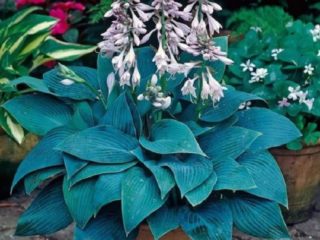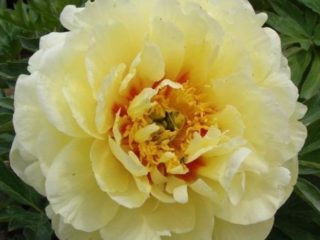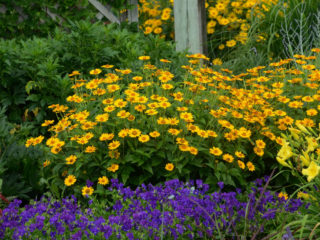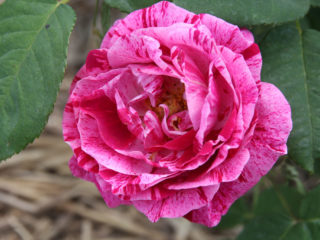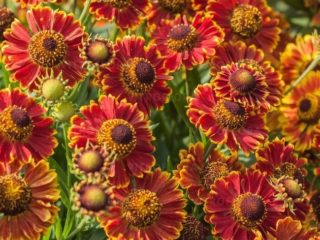Content
Yarrow is a perennial herbaceous plant with a bitter aroma, which is found in the steppe, in forests among shrubs. The culture is considered medicinal, but inconspicuous. However, this cannot be said about decorative yarrow. This variety is not only characterized by a variety of shades and long flowering, but also unpretentiousness. Therefore, many gardeners prefer to use it for landscaping their garden plots. In order for the plant to fully develop and bloom profusely, planting and caring for yarrow are carried out taking into account the requirements of the culture.

Yarrow is a member of the Asteraceae family
Sowing yarrow seeds for seedlings at home
In order to have already strong seedlings of this ornamental plant at the beginning of the season, which will delight you with flowering this season, it is recommended to first grow the seedlings at home.But for this you need to know how to land correctly.
When to sow yarrow seeds for seedlings
The decorative type of crop is characterized by a fairly long growing season. Therefore, it is necessary to plant yarrow seeds for seedlings in the southern regions of the country no later than mid-February. And when growing perennials in the middle zone and northern regions, it is recommended to postpone planting for 1-2 weeks.
Do I need to stratify yarrow seeds?
There is debate about the need to stratify yarrow seeds. Some gardeners argue that this procedure is necessary because it softens the outer shell of the seeds, which guarantees the appearance of friendly shoots. However, as practice shows, yarrow seeds germinate well with or without planting. Therefore, each gardener decides for himself whether this procedure is necessary or not.
Planting scheme
To sow yarrow for seedlings, you need to prepare wide containers with drainage holes, 6-8 cm high. They must have drainage holes. You will also need nutritious loose soil for planting, consisting of turf, sand, peat and humus in a ratio of 2:1:1:1; it is additionally recommended to add a little perlite to it. And then mix everything thoroughly.

Before sowing, it is recommended to soak perennial seeds for 24 hours in a Zircon solution, which stimulates their rapid germination.
The procedure for planting yarrow seeds in the spring for seedlings:
- Fill the prepared container with the substrate, leaving 1 cm short of the top. Water it and wait until the moisture is absorbed. Lightly level and compact the soil surface.
- Place the seeds at a distance of 2 cm from each other. Sprinkle them with a layer of soil 0.5-0.7 cm thick. Re-moisten the surface of the soil with a spray bottle.
- Cover the container with a transparent lid and transfer it to a shaded place with a temperature of +23-25 °C.
Every day, yarrow crops must be ventilated and accumulated condensation removed from the lid. If all conditions are met, seedlings appear 7-10 days after planting. If sprouts sprout en masse, it is necessary to move the container to a bright windowsill and lower the maintenance regime to +20 °C. This will enhance the development of the root system.
In the future, when the yarrow seedlings grow and become stronger, they must be adapted to external conditions. To do this, it is recommended to remove the lid from the container for the first time for half an hour, and with each subsequent day increase the time interval by another 30 minutes. After a week, the lid can be completely removed from the yarrow seedlings.
Further care consists of periodically watering the plants as the top layer of soil dries. It is also necessary to provide twelve hours of daylight. Therefore, in the evening you need to turn on an additional lamp so that the seedlings do not stretch out.
When the seedlings have 2-3 pairs of true leaves, they need to be planted in separate containers with a diameter of 8-9 cm. In this case, you can use the same soil as when sowing seeds. When picking, there is no need to bury the seedlings; their root collar should be at soil level.
After a week, it is necessary to fertilize the yarrow seedlings for the first time. The Kemira Universal complex mineral fertilizer is suitable for this. Seedlings can be planted in open ground when the threat of frost has passed and the soil has warmed to a depth of 10-15 cm.The recommended planting pattern is 30 by 30 cm.

Perennial seedlings react poorly to root damage
How to plant yarrow in open ground
Sowing decorative yarrow seeds can also be done directly in open ground. In this case, you need to prepare the site at least two weeks in advance. To do this, you will need to dig it up, carefully level the surface and prepare the furrows.
Planting seeds can be done in mid-autumn or early May. In the first case, the planting depth is 3 cm, and in the second - 1 cm. After planting, the area must be watered abundantly and covered with agrofibre.
When sprouts appear, they need to be thinned out, maintaining a distance of 5 cm between plants. At the stage of 2-3 true leaves, it is recommended to feed yarrow seedlings.
Nitroammophoska or Kemira Universal are suitable for this. And when the yarrow bushes become lush and well strengthened, it is necessary to plant them in a permanent place. When carrying out the procedure, it is recommended to transport the plants with a lump of earth on the roots. Planting of seedlings should be done at a distance of 30 cm.
How to care for yarrow
Decorative yarrow, in addition to other advantages, is also unpretentious in care. This perennial is able to fully develop and bloom profusely even when planted in depleted sandy soil. The main thing is that the soil is loose and neutral.
Both open sunny areas and slightly shaded areas are suitable for yarrow. But in the first case, its flowering will be more abundant.

When choosing a location, you need to take into account that yarrow will grow every year, so it can inhibit the growth of neighboring crops
Watering
It is necessary to water the perennial regularly after planting it in a permanent place. When the plant adapts and begins to grow, moisturizing should be done once a week. During hot periods, a layer of humus 2 cm thick should be laid at the base of the bushes. This will prevent excessive evaporation of moisture from the soil and overheating of the roots.
Fertilizer
Decorative yarrow needs to be fed twice a season. It is recommended to apply fertilizers for the first time in the spring at the beginning of the growing season. During this period, you can use nitroammophoska at the rate of 20 g per plant.
The second feeding for perennials is recommended in mid-July. At this time, it is necessary to add 20 g of superphosphate and 15 g of potassium sulfide. It is recommended to sprinkle fertilizers at the base of the perennial and then incorporate it into the soil.

The flowering period of yarrow begins at the end of June and continues until September.
Trimming
To maintain the high decorative value of the plant, it is necessary to periodically prune it throughout the season. Broken stems and wilted peduncles must be removed. In late autumn, yarrow must be cut at a height of 10-15 cm.
Preparing for winter
The plant does not need careful preparation for wintering. Cover sufficiently pruned bushes with a layer of humus to insulate the roots. Decorative yarrow should be sprinkled with foliage on top, only in regions with little snow in winters.
It is recommended to remove the cover from the perennial in early spring, without waiting for constant heat, in order to prevent the roots from getting warm.
How to propagate yarrow
To obtain new yarrow seedlings, you can use cuttings and the method of dividing the bush.Each of the proposed methods does not cause any particular difficulties, but has certain features.
Cuttings
It is recommended to cut perennials in June before flowering begins. To do this, you need to cut the tops of the shoots with three buds. After this, powder the lower cut with Kornevin and immediately plant it in cups or in a garden bed, and then water it generously.
To successfully root yarrow cuttings, you need to build a mini-greenhouse over the seedlings. It is recommended to ventilate it daily. If all conditions are met, yarrow cuttings will take root after two weeks.

Young seedlings can be planted in a permanent place when they become stronger and grow up
Dividing the bush
This propagation method is recommended for perennial bushes older than three years. The procedure should be carried out in early spring or late autumn.
To do this, you need to dig up the mother plant from all sides, carefully remove it from the ground and use a sharp pruner or knife to divide it into parts. Each of them should have a growing point and well-developed root processes. After this, you need to immediately plant the cuttings in a permanent place and water them abundantly.
Possible problems during cultivation
Growing yarrow does not pose any particular difficulties, even for novice gardeners. But sometimes mistakes made during planting and care can cause some problems.
Among them:
- Striped weevil. The pest attacks weakened bushes. This slows down their growth, causes yellowing of the leaves and causes poor flowering.
To combat weevils, it is recommended to spray the plants with chlorophos and treat the soil with hexachlorane
- Sparse flowering. The problem occurs when the bushes are insufficiently illuminated.
If flowering is poor, you need to replant the plant taking into account the requirements of the culture
- Slow growth after planting in a new location. This occurs when seedlings are buried too deep. It is necessary to raise the plant so that its root collar is at soil level.
Perennial has high immunity to diseases
Use in landscape design
As you can see in the photo, with proper planting and care, decorative yarrow looks very impressive as an element of landscape design. It is great for decorating borders, alpine slides, lawns and lawns. Moreover, the plant can be planted both in single plantings and in combination with other garden crops.
Suitable companions:
- bells;
- carnation;
- catnip;
- delphinium;
- digitalis;
- sage;
- lavender;
- zinnias;
- crocosmia.

When choosing neighbors, you should also select low-maintenance plants.
Conclusion
Planting and caring for yarrow does not cause any particular difficulties. After all, this culture is one of the undemanding and hardy ones. It is enough to follow the standard rules of agricultural technology so that the plant looks elegant throughout the season. After all, with the arrival of spring, it begins to actively grow lacy greenery of a bright shade, and then blooms for more than three months. Therefore, yarrow is able to compete with most garden crops.







